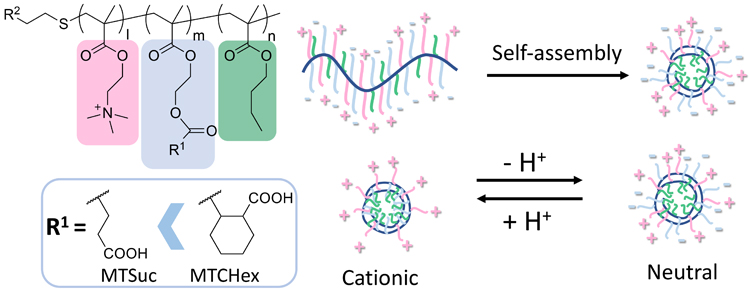Research outcomes of the Program for the Advancement of Next Generation Research Projects
Faculty of Science and Technology
Yuki Hiruta
Water-soluble polymers such as polyethylene glycol (PEG) are expected to have applications in the biomedical field as biocompatible materials, and in fact, they are already being clinically used as solubilizers and stabilizers for pharmaceutical products. For example, mRNA vaccines are used for COVID-19, but since they are unstable, they are encapsulated in artificial lipid nanoparticles (liposomes) that are surface-modified with PEG. PEG acts to hinder nonspecific attachment of blood proteins and cells by the strong hydration layer and a large hydrodynamic radius owing to its high mobility. However, because of these characteristics, several drawbacks have also been reported, such as the selectivity for target cells, and reduced cellular uptake.
Stimuli-responsive polymers recognize changes in the surrounding environment, such as temperature and pH, and change their properties and shape accordingly. Since they can switch between hydrophilic/hydrophobic and charge states depending on stimuli, they have the characteristics of the water-soluble polymers described above and can enhance interactions with biomolecules and cells by providing specific stimuli.1
Poly[oligo(ethylene glycol) methyl ether methacrylate] (POEGMA) with brush-like ethylene glycol groups on the side chains is expected to be applied in the biomedical field due to their biocompatibility and temperature-responsive characteristics. We evaluated the effect of molecular weight of POEGMA on its biodistribution. POEGMA derivatives with different molecular weights of 10,000, 21,000, and 30,000 g/mol were synthesized and labeled with radioisotopes (indium-111) by introducing the chelating agent, DOTA, at their terminal moiety. POEGMA derivatives were intravenously injected into tumor-bearing mice and the distributions in various organs were evaluated. As the molecular weight of POEGMA increased, there was prolonged blood retention, but there was also an increased accumulation of POEGMA in the liver and spleen. POEGMA with a molecular weight of 21,000 g/mol saw a significant accumulation in tumors, confirming a relatively good tumor-to-normal tissue ratio. POEGMA derivatives with a molecular weight of 21,000 g/mol was also labeled with a near-infrared fluorescent dye, indocyanine green (ICG), and applied to real-time fluorescence imaging guided tumor resection surgery (Figure 1).2

Figure1:
Schematic image of POEGMA-based tumor-targeted carriers of diagnostic drugs. Reprinted with permission from K. Sano, K. Umemoto, H. Miura, S. Ohno, K. Iwata, R. Kawakami, M. Munekane, T. Yamasaki, D. Citterio, Y. Hiruta, T. Mukai, ACS Appl. Polym. Mater. 2022, 4(7), 4734-4740. Copyright 2022 American Chemical Society.
Zwitterionic polymers, which have both cationic and anionic charges, are also gaining attention as an alternative to PEG. These polymers also have a strong hydration layer. In addition, previous research has shown that Zwitterionic polymers have a strong affinity for cancer cell membranes. Furthermore, those with pH-responsive moieties can acquire pH-dependent selectivity for their targets. In particular, since tumor microenvironments are weakly acidic environments, when targeting them, they can acquire selectivity for cancer cells by becoming net-neutral in the blood environment and cationic in the tumor environment. In this study, we developed pH-responsive mixed-charge polymers to evaluate the effect of hydrophobicity of their side chains on their interaction with cells in a weakly acidic environment (Figure 2). pH-responsive mixed-charge polymers have equal amounts of cationic and pH-responsive anionic moieties and different proportions of hydrophobic moieties and change their surface charge in response to weakly acidic environments. The pH-responsive mixed-charge polymers formed a micelle in aqueous solutions, and the increased hydrophobicity of the side chains was confirmed to shift the surface charge to change at pH levels more similar to the tumor microenvironment. It was confirmed that the cytotoxicity to HeLa cells increased in weakly acidic environments. The cationic nature of the micelle surface causes adsorption to the cell membrane, and the high hydrophobicity of the polymer side chains caused high affinity with the cell membrane, which disrupts its integrity. These results indicate that pH-responsive mixed-charge polymers have the potential for drug-free cancer treatment.3

Figure2:
Schematic image of pH-responsive mixed-charge polymers. Reprinted from Y. Nakamura, M. Nasu, Y. Shindo, K. Oka, D. Citterio, Y. Hiruta, Polym. J. Effect of the side chain composition of mixed-charge polymers on pH-selective cell-membrane interactions. Copyright 2023 The Society of Polymer Science, Japan.
This work was partially supported by the Program for the Promotion of Next Generation Research Projects.
Reference
- Hiruta, Y. Poly(N-isopropylacrylamide)-based temperature- and pH-responsive polymer materials for application in biomedical fields. Polym. J. 2022, 54, 1419-1430.
- Sano, K.; Umemoto, K.; Miura, H.; Ohno, S.; Iwata, K.; Kawakami, R.; Munekane, M.; Yamasaki, T.; Citterio, D.; Hiruta, Y.; Mukai, T. Feasibility of Using Poly[oligo(ethylene glycol) Methyl Ether Methacrylate] as Tumor-Targeted Carriers of Diagnostic Drugs. ACS Appl. Polym. Mater. 2022, 4, 4734-4740.
- Nakamura, Y.; Nasu, M.; Shindo, Y.; Oka, K.; Citterio, D.; Hiruta, Y. Effect of the side chain composition of mixed-charge polymers on pH-selective cell-membrane interactions. Polym. J. 2023, 55, 1179-1188.
Keio University Program for the Advancement of Next Generation Research Projects
The Keio University Program for the Advancement of Next Generation Research Projects subsidizes research costs with the aim of finding solutions to challenges and of promoting global academic research in order to allow Keio University faculty members to establish a presence as core researchers.